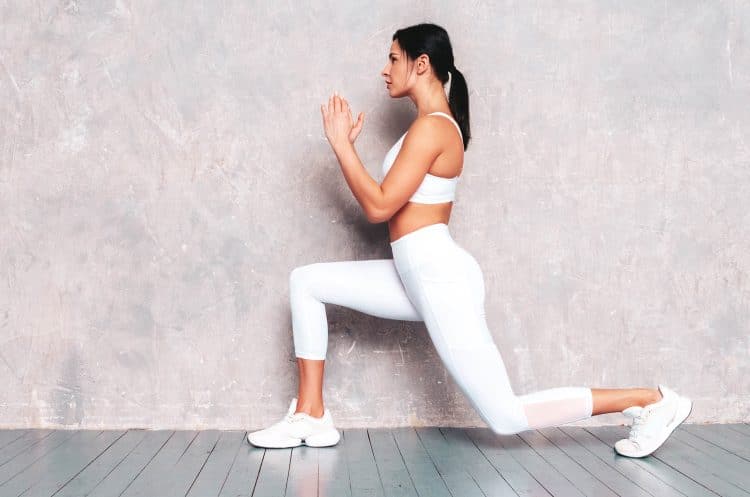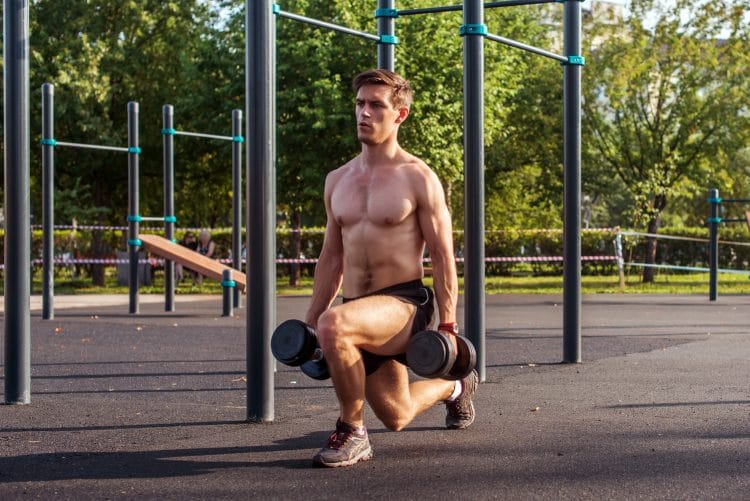Calorie Calculator Doing Lunges
You can expect to burn about 5.7 calories for each minute you do lunges, which equates to 344 calories per hour doing lunges (moderate effort) and burn approximately 515 calories per hour doing lunges (heavy effort).
The number of calories you burn doing lunges and other similar exercises depends on your weight and body composition, so be sure to use the calculator below and take a look at all the other calorie calculators we have to offer.
[sc name=”cbfc-lunges-98″ ][/sc]
Calories Burned with Home Exercises (Weight: 175lbs)
| MET | 15 mins. | 30 mins. | 45 mins. | 60 mins. | |
|---|---|---|---|---|---|
| Abs Exercises | 7 | 146 | 292 | 438 | 583 |
| Burpees | 8 | 167 | 333 | 500 | 667 |
| Jumping Rope | 8.8 | 183 | 367 | 550 | 733 |
| Squats | 5.5 | 115 | 229 | 344 | 458 |
| Jumping Jacks | 7.7 | 160 | 321 | 481 | 642 |
| Sit-Ups | 8 | 167 | 333 | 500 | 667 |
| Lunges | 4 | 83 | 167 | 250 | 333 |
| Kettlebells | 8 | 167 | 333 | 500 | 667 |
| Push-Ups | 3.8 | 79 | 158 | 238 | 317 |
| Rowing | 4.8 | 100 | 200 | 300 | 400 |
| Bridges | 3 | 63 | 125 | 188 | 250 |
| Deadlifting | 6 | 125 | 250 | 375 | 500 |
| Calisthenics - Vigorous | 8 | 167 | 333 | 500 | 667 |
How to Do Lunges
- Stand tall with your feet together and your hands by your sides. Look straight ahead the entire time you’re doing lunges. Be sure to lock in and brace your abs.
- Take one large step forward and into a split stance.
- Bend your legs and lower your back knee down within about an inch of the floor. Ensure that your knee does not touch the ground when doing lunges.
- Your front shin should be totally vertical or very close to it. Do NOT let it move forward past your toes, as doing so puts a lot of stress on the knees.
- Your back thigh should be close to vertical, and about half of your weight should be on your front leg.
- Push off your front leg and return to the starting position, and do all your reps leading with the same leg or alternate legs as preferred.

These steps should get you started with the basic form of doing lunges and the basics of how to perform the exercise.
[sc name=’style-summary2′ ]
Check out our Lunges Guide that goes more in-depth on how to perform lunges safely with more pointers and tips that you can use to perfect your form when doing lunges.
[/sc]
Benefits of Lunges
Since lunges work many different parts of your legs and help you build muscle, there are plenty of additional benefits that you’ll find if you start doing lunges regularly.
First, lunges help tremendously with your balance and stability. Since you work each side of your body independently, lunges force you to use your balance to complete each repetition.
As you do lunges more frequently, you’ll notice that your balance and stability will start to improve and you can do more lunges for longer sessions.
Lunges are also great for strengthening your back and core muscles while putting minimal stress on your spine. Having a stable core will help to improve your posture and reduce the chances of injury.
Perhaps the most important benefit that lunges provide is that they allow you to build muscle in your lower body better than many other exercises. Many people will use additional weight to increase the resistance when doing lunges.
For example, some people may hold dumbbells in their hands or a medicine ball to further develop the lower body. People may also add twists and turns while doing lunges, which are variations that we will cover later in this article.
How the Calculator Works
The lunges calculator uses MET values to give you an estimate of how many calories you can expect to burn while performing lunges and doing other activities. The higher the MET value means that the activity forces you to expend more energy, therefore you’ll burn more calories.
MET (Metabolic Equivalent of Task)
But what is a MET value? MET stands for metabolic equivalent of task, and these values give us an idea of how much energy is required to perform lunges and other exercises.
The MET value is a ratio between the two metabolic rates: the working metabolic rate and the resting metabolic rate [1]. These metabolic rates are the rates that energy is used relative to the duration of time spent doing activities such as lunges.
It’s important to know that a MET value of 1 is the equivalent of the amount of energy you expend while at rest, and each MET value is relative to the energy you expend at rest. Some MET values for activities like skating can go up to a MET value of 13!
Formula
The formula that our lunges calculator uses to determine the number of calories burned per minute is (bodyweight in Kg x MET x 3.5) ÷ 200.
Examples
A person weighing 180 pounds will burn approximately 343 calories per hour from doing lunges. This activity has a MET of 4, which means that it burns 4 times as many calories compared to being at rest.
This is what the formula for calculating the calories burned while doing lunges will look like for a 180-pound individual at a MET value of 4.
- Calories burned (per minute) = (body weight in kg x MET x 5) ÷ 200
- Calories burned (per minute) = ( 81.6 x 4 x 5 ) ÷ 200
- Calories burned (per minute) = 7 calories x 60
- Calories burned (per hour) = 343 calories per hour
[sc name=”calorie-cal”]
Lunge Variations
While the standard lunge is a great exercise to get started with, there are plenty of lunge variations that you should try in order to target different muscles and mix up your workout routine.
The dumbbell lunge

As we mentioned previously, doing lunges with added resistance will help to build muscle faster and enhance the fat-burning effects of working out your lower body. One of the most popular variations of lunges is the dumbbell lunge.
This is a beginner-friendly variation that primarily targets the glutes, hamstrings, and quadriceps. It involves holding a dumbbell in each hand and doing alternating lunges following the steps we’ve outlined above.
If you don’t have access to dumbbells, you can accomplish the same effects of resistance by using any type of weighted object in your hands. Using items like a water jug or a backpack can be very useful if you don’t have dumbbells handy.
The barbell lunge

The barbell lunge is another variation that is best suited for intermediate weightlifters since there is some developed skill that’s required to balance the weight and perform the exercise at the same time. Once you get the hang of it, you’ll be set to make some serious gains!
We recommend getting the form of a regular lunge down before you progress to the barbell lunge.
In addition, this exercise is great because you can target different muscles based on how far you lunge. The further out you lunge, the more you’ll work your glutes while the shorter your stride means you’ll emphasize your quads.
The barbell lunge also has similar benefits to the regular lunge, including benefits like improving coordination, balance, unilateral strength, athletic performance, and explosiveness.
Split squat
Split squats are one of the simplest variations of lunges but perhaps the most exhausting. This exercise involves using two dumbbells and placing one foot on the edge of a bench. Then you extend your other leg about 3-4 feet from the bench.
Keeping your back straight, squat down until your upper leg is about parallel to the floor, making sure to continuously do controlled inhales as you’re performing the exercise. Then you drive your legs upwards without locking your knees at the top.
You will certainly feel the effects of split squats in your quads and hamstrings, and you can even use a barbell for the split squat if you are a more advanced weightlifter. This exercise also works the hamstrings, glutes, calves, and core.
We recommend starting with just your body weight at first to ensure that you have the correct form before adding more resistance to the split squat.
Frequently Asked Questions:
How many calories do you burn per lunge?
Approximately 0.3 calories are burned with one lunge.
Based on your weight and intensity, a stationary lunge burns approximately 6 calories per minute. Each lunge takes approximately three seconds (20 lunges per minute).
Do lunges burn a lot of calories?
Exercises like lunging are high-intensity. A person who weighs 150 pounds will burn 275 calories in 30 minutes of lunging exercise.
The Bottom Line
Lunges are one of the best exercises you can do if you want to build muscle in your lower body and get a great workout in the process. It’s very important to make sure you have the correct form before doing any type of exercise to avoid injury.
With all the lunge variations out there, you should try some of them to see what you like the best and to mix things up with your workout if you tend to get bored of doing the same exercises over and over again.
Use our lunge calculator to find out how many calories you can burn while doing lunges, and be sure to check out all the other calculators that we have to offer at Fitness Volt!
References:
- Jetté, M., Sidney, K., & Blümchen, G. (1990). Metabolic equivalents (METS) in exercise testing, exercise prescription, and evaluation of functional capacity. Clinical cardiology, 13(8), 555–565. https://doi.org/10.1002/clc.4960130809


